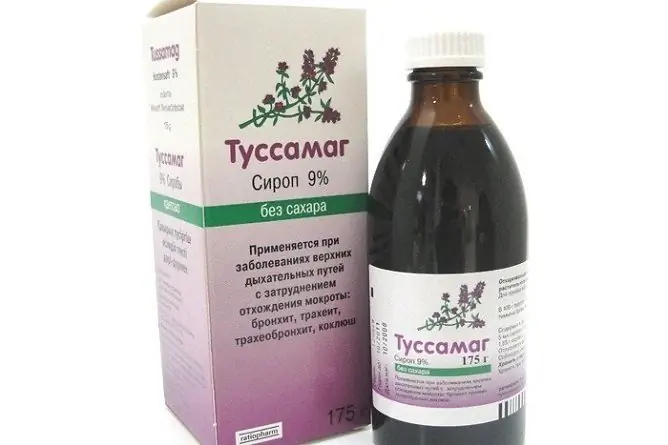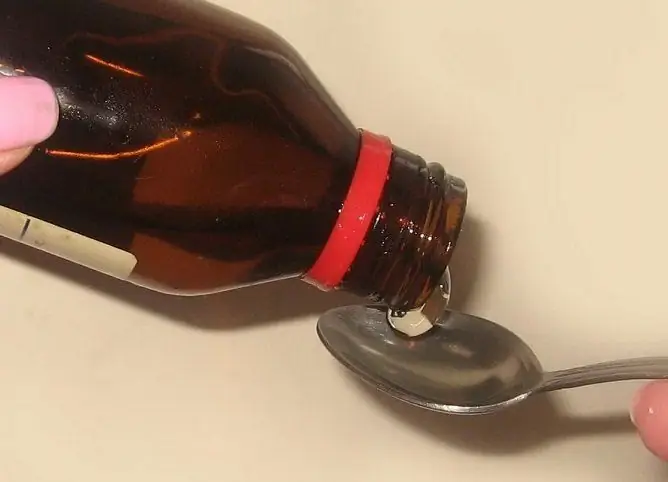- Author Rachel Wainwright [email protected].
- Public 2023-12-15 07:39.
- Last modified 2025-11-02 20:14.
Loratadin
Loratadin: instructions for use and reviews
- 1. Release form and composition
- 2. Pharmacological properties
- 3. Indications for use
- 4. Contraindications
- 5. Method of application and dosage
- 6. Side effects
- 7. Overdose
- 8. Special instructions
- 9. Drug interactions
- 10. Analogs
- 11. Terms and conditions of storage
- 12. Terms of dispensing from pharmacies
- 13. Reviews
- 14. Price in pharmacies
Latin name: Loratadine
ATX code: R06AX13
Active ingredient: loratadine (loratadine)
Producer: JSC Biosintez, JSC Tatkhimfarmpreparaty, JSC VERTEX, Pharmacor Production, LLC Ozon (Russia), Morepen Laboratories, Hetero Drugs, Tonira Pharma (India), Natur Produkt Europe BV (Netherlands)
Description and photo update: 2019-13-08
Prices in pharmacies: from 18 rubles.
Buy

Loratadine - antiallergic agent, blocker of H 1 -receptors.
Release form and composition
Dosage forms:
- Tablets: almost white or white, round flat-cylindrical shape, with a chamfer and dividing line (10 pcs. In a blister strip, in a cardboard box 1, 2 or 3 packs; 10 pcs. In blisters or strips, in a cardboard box 1 blister or 1 strip; 10 pcs. in polymer cans, in a cardboard box 1 can; 30 pcs. in a blister strip, in a cardboard box 1 package);
- Syrup (50 or 100 ml in glass bottles of dark color, in a cardboard box 1 bottle complete with a dosing cup or spoon).
The active substance is loratadine:
- 1 tablet - 10 mg;
- 5 ml of syrup - 5 mg.
Auxiliary components of Loratadine tablets: lactose monohydrate, corn starch, colloidal silicon dioxide, magnesium stearate, sodium carboxymethyl starch, microcrystalline cellulose, talc.
Auxiliary components of the Loratadine syrup: propyl parahydroxybenzoate (E 218), methyl parahydroxybenzoate (E 216), citric acid monohydrate, sodium saccharin, propylene glycol, sorbitol solution (contains E 420, does not crystallize), glycerin, purified water, flavoring 434 (Forest strawberry AKF contains E 124, E 122).
Pharmacological properties
Pharmacodynamics
Loratadine is a tricyclic compound with a pronounced antihistamine effect. It belongs to the selective blockers of peripheral H 1 -histamine receptors, characterized by a fast and prolonged antiallergic action. The drug takes effect within 30 minutes after oral administration. The maximum antihistamine effect is recorded 8-12 hours after the onset of loratadine action and lasts more than 1 day.
Loratadine lacks the ability to penetrate the blood-brain barrier, and it also does not affect the processes occurring in the central nervous system. It is not characterized by clinically significant sedative and anticholinergic effects, that is, the use of the drug does not lead to drowsiness and does not change the speed of psychomotor reactions when taken in therapeutic doses. Treatment with loratadine does not prolong the QT interval on the ECG.
With long-term therapy, there were no clinically significant changes in the results of laboratory tests or electrocardiography, physical examination data and parameters of vital functions.
Loratadine is not characterized by significant selectivity for H 2 -histamine receptors. It does not inhibit the reuptake of norepinephrine and practically does not affect the function of the pacemaker or the state of the cardiovascular system.
Pharmacokinetics
Loratadine is rapidly and largely absorbed from the gastrointestinal tract. Its maximum concentration in blood plasma is reached in 1-1.5 hours. For the active metabolite of this substance, desloratadine, this indicator is 1.5-3.7 hours. Taking the drug with meals increases the time to reach the maximum concentration of the active substance itself and desloratadine for about 1 hour, but does not affect the effectiveness of the drug. The value of the maximum concentration of loratadine and desloratadine does not depend on food intake.
In patients with chronic kidney disease, the maximum concentration and AUC (area under the concentration-time curve) of loratadine and its metabolite, which has pharmacological activity, are increased compared with patients with normal renal function. At the same time, the values of the half-lives of loratadine and desloratadine in patients with renal dysfunction practically do not change.
In patients with alcoholic liver damage, AUC and the maximum concentration of loratadine and desloratadine are doubled compared to patients with normal liver function.
Loratadine binds to plasma proteins to a high degree (about 97-99%). Its metabolite desloratadine exhibits a moderate degree of binding to plasma proteins (about 73-76%).
The metabolic process, during which loratadine is converted to desloratadine, is carried out with the participation of the cytochrome P4503A4 system and, to a lesser extent, the cytochrome P4502D6 system.
The drug is excreted in urine (approximately 40% of the oral dose) and feces (approximately 42% of the oral dose) for more than 10 days, mainly in the form of conjugated metabolites. About 27% of an oral dose is excreted through the kidneys within 24 hours after taking Loratadine. Less than 1% of the active component of the drug is excreted unchanged in the urine within 24 hours after administration.
The bioavailability of loratadine and desloratadine is directly proportional to the dose taken.
Studies involving adult and elderly healthy volunteers have shown that the pharmacokinetic profiles of loratadine and its metabolite in both cases remain almost identical.
The half-life of loratadine varies from 3 to 20 hours (on average, this parameter is 8.4 hours), and desloratadine - from 8.8 to 92 hours (the average value of the parameter is 28 hours). In elderly patients, this indicator is 6.7-37 hours (on average 18.2 hours) and 11-39 hours (on average 17.5 hours), respectively. In liver damage associated with alcohol abuse, the half-life is increased (the exact value is determined by the severity of the disease) and remains unchanged in the presence of chronic renal failure.
In patients with chronic renal failure, hemodialysis sessions have no significant effect on the pharmacokinetic parameters of loratadine and desloratadine.
Indications for use
- Year-round and seasonal allergic conjunctivitis, rhinitis, acute urticaria, Quincke's edema;
- Allergic reactions caused by insect bites;
- Pseudoallergic syndromes with symptoms of histaminergias caused by the use of histaminoliberates;
- Complex therapy of pruritic dermatoses, including chronic eczema and contact allergic dermatitis.
Contraindications
- The period of pregnancy and breastfeeding;
- Age up to 2 years;
- Hypersensitivity to drug components.
Instructions for the use of Loratadin: method and dosage
According to the instructions, Loratadin in the form of tablets or syrup is taken orally 1 time per day.
Recommended daily dosage:
- Patients over 12 years old and children weighing more than 30 kg - 10 mg;
- Children 2-12 years old and weighing up to 30 kg - 5 mg.
Side effects
- Cardiovascular system: rarely - tachycardia;
- Nervous system: rarely - headache, increased fatigue, in children - excitability;
- Digestive system: rarely - nausea, dry mouth, gastritis, vomiting; in some cases - functional disorders of the liver;
- Allergic reactions: rarely - skin rash; in isolated cases - anaphylactic reactions;
- Dermatological reactions: in some cases - alopecia.
Overdose
An overdose is manifested by symptoms such as headache, tachycardia, drowsiness. In this case, you must immediately contact a specialist who usually prescribes supportive and symptomatic therapy. Gastric lavage and absorption of adsorbents are allowed (activated carbon is crushed and mixed with water). Hemodialysis to remove loratadine from the body is considered ineffective. After providing emergency care, it is recommended to continue monitoring the patient's condition.
special instructions
The development of convulsive conditions, especially in predisposed patients, cannot be completely ruled out when taking loratadine.
The use of the drug in case of impaired renal or liver function is possible only after an appropriate dose adjustment.
Influence on the ability to drive vehicles and complex mechanisms
No negative effects of loratadine on the ability to drive vehicles or perform work requiring increased concentration and concentration of attention have been identified.
However, there are isolated cases of drowsiness when taking the drug, which can affect the patient's ability to fully drive a car or work with complex mechanisms.
Drug interactions
The combination of Loratadine with drugs that inhibit the isoenzymes CYP2D6 and CYP3A4, or those that are metabolized in the liver with their participation, including erythromycin, cimetidine, ketoconazole, fluconazole, quinidine, fluoxetine, may contribute to a change in the plasma level of these agents and / or l …
Concomitant use with ethanol, phenytoin, barbiturates, tricyclic antidepressants, rifampicin, zixorin, phenylbutazone (inducers of microsomal oxidation) causes a decrease in the clinical efficacy of loratadine.
Analogs
Loratadin analogs are: Loratadin-Akrikhin, Lorahexal, Lomilan, Claritin, Clarisens, Erolin, Loratadin-Teva, Loratadin-Verte, Loratadin Stoma, Loratadin Stada, Loratadin-OBL, Alerpriv, Klallerridol, Klargotil, Klariolol, Lotaren, Allerfex, Diazolin, Dimebon, Dinox, Ketotifen, Nalorius, Peritol, Telfast, Fenkarol, Erius, Desloratadin.
Terms and conditions of storage
Store in a dry, dark place at temperatures up to 25 ° C. Keep out of the reach of children.
The shelf life is 3 years.
Terms of dispensing from pharmacies
Available without a prescription.
Reviews about Loratadin
According to reviews, Loratadin is one of the most popular 2nd generation antiallergic drugs. Compared with some analogues, it is characterized by a significantly higher antihistaminic activity, which is due to a higher binding strength with peripheral receptors belonging to the H 1 type.
Experts say that Loratadine does not show a sedative effect, is not characterized by a cardiotoxic effect, does not enhance the effect of ethyl alcohol, practically does not interact with other drugs and does not cause addiction.
Many patients consider Loratadine syrup and tablets to be an effective and affordable drug with a mild and prolonged effect. It is also very easy to use for both adults and children.
Loratadin price in pharmacies
The approximate price for Loratadine in the form of tablets depends on the manufacturer and ranges from 24 to 55 rubles (for a package containing 10 pcs.) Or from 55 to 239 rubles (for a package containing 30 pcs.). The syrup can be purchased for 148-178 rubles (for a 100 ml bottle).
Loratadin: prices in online pharmacies
|
Drug name Price Pharmacy |
|
Loratadin 10 mg tablets 10 pcs. RUB 18 Buy |
|
Loratadin 10 mg tablets 10 pcs. RUB 18 Buy |
|
Loratadin 10 mg tablets 10 pcs. RUB 18 Buy |
|
Loratadin 10 mg tablets 10 pcs. RUB 19 Buy |
|
Loratadin 10 mg tablets 10 pcs. RUB 21 Buy |
|
Loratadin tab. 10mg No. 10 RUB 27 Buy |
|
Loratadin tablets 10mg 10 pcs. 28 RUB Buy |
|
Loratadin 10 mg tablets 30 pcs. 32 RUB Buy |
|
Loratadin 10 mg tablets 10 pcs. RUB 40 Buy |
|
Loratadin tablets 10mg 10 pcs. Pharmacor 41 rbl. Buy |
|
Loratadin Stada 10 mg tablets 10 pcs. RUB 49 Buy |
|
Loratadine 5 mg / 5 ml syrup 100 ml 1 pc. RUB 51 Buy |
|
Loratadin 10 mg tablets 30 pcs. RUB 54 Buy |
|
Loratadin tablets 10mg 30 pcs. Ozone RUB 67 Buy |
|
Loratadin 10 mg tablets 30 pcs. RUB 68 Buy |
|
Loratadin 10 mg tablets 30 pcs. 73 rbl. Buy |
|
Loratadin tablets 10mg 30 pcs. Synthesis 82 RUB Buy |
|
Loratadin 10 mg tablets 30 pcs. 83 rbl. Buy |
|
Loratadin tablets 10mg 10pcs RUB 96 Buy |
|
Loratadin 10 mg tablets 10 pcs. 142 RUB Buy |
|
Loratadin tablets 10mg 30pcs RUB 176 Buy |
| See all offers from pharmacies |

Maria Kulkes Medical journalist About the author
Education: First Moscow State Medical University named after I. M. Sechenov, specialty "General Medicine".
Information about the drug is generalized, provided for informational purposes only and does not replace the official instructions. Self-medication is hazardous to health!






